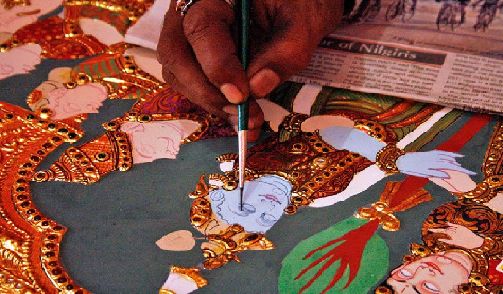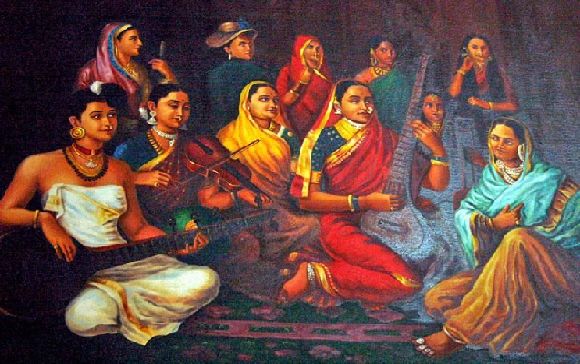Mysore Paintings
Sep 25, 2019 • 510 views
Origin and Background
As the name suggests, Mysore paintings originated in and around the region of Mysore in the state of Karnataka. The paintings have a long, rich history attached to them which dates back to the end of the Vijayanagar empire during the period 1565 AD. Mysore paintings, in reality, are an evolved form of Vijayanagar school of paintings. The story behind this evolution and the birth of a new form of painting takes us back to the fall of the Vijayanagar empire and what were the consequences faced by local artisans. Vijayanagar which was quite rich in terms of art and literature, faced a lot of distress when it came to its artisans. With the defeat of the Vijayanagar rulers, the patronage of the artisans went away too. To cope with this distress, they migrated to different places such as Mysore, Raichur, Tanjore etc. This settlement of the Vijayanagar artists in different places led to the fusion of the Vijayanagar school of painting and the culture and styles of the places to which these artisans moved to, hence in the region of Mysore, a new form of painting was born called the Mysore painting.

Mysore Painting - Source: Hi Bengaluru
Methods and Significant Characteristics
Correct preparation is an essential thing to get the right and desirable outcome. Knowing the right kind of materials that are to be used, collecting them and having the knowledge of how to use them are some of the most essential steps of making a good painting and Mysore paintings are no different. Earlier, the painters used to prepare the required materials on their own. They used naturally available substances to prepare the paints as well as make the brushes. To make colors, natural sources such as leaves, vegetables, flowers, stones etc were used. The brushes were made out of animal hair which includes goat hair, squirrel hair, camel hair, etc. For the execution of certain kinds of elements, special sharp and pointy brushes made out of a specific type of grass were used.
The following are the basic steps for the execution of Mysore paintings -
The first step is to prepare the base. Earlier the base was prepared using different materials such as paper, cloth, and wood. For each one of them different techniques are applied such as for paper base, a number of waste sheets are used over which a drawing sheet is stuck followed by a paste of refined flour and then dried in the sun. In the current times, however, instead of these materials, the base is usually prepared by sticking an ivory or cartridge sheet on a mount board.
Next comes the part of designing. A rough sketch of the design is drawn onto the base usually using a crayon made out of tamarind twigs.
After the sketching is done, the work of painting needs to be started. Considering there are usually a lot of elements in the painting, the work starts generally with the broader and farther elements such as the sky, rivers etc and then moves to smaller and intricate figures of humans and animals which need detailing.

Application of Gold Foil - Source: Dsource
A paste made out of zinc oxide and Arabic gum called the ‘gesso’ paste is an important element in Mysore paintings. This paste is applied onto the base for the very reason of providing a raised effect so as to highlight the embellishments and other intricate details that would be painted on them. Usually, gold foil is applied on these raised surfaces made by the application of gesso paste.

Mysore Painting in Finishing Stage - Source: Dsource

Mysore Painting Inspired by Mythology - Source: Pinterest
Mysore paintings derive their inspiration highly from mythological and religious tales. Depiction of various scenes from mythological tales and portrayal of Gods and Goddesses are the most common themes around which these paintings revolve. Paintings showing coronation of Lord Rama, figures of Goddesses Lakshmi and Saraswathi are few of the many examples of the themes in these paintings. Certain striking characteristics of Mysore paintings include eyes having the shape of a fish, Mysore turbans, traditional Mysore royal hairdos and jewellery and rounded face.
Mysore Paintings in Inscriptions and Literary World
Mysore Paintings are very clearly mentioned in a lot of literary texts, whether in the form of guidebooks that explain the process of these paintings or as texts which include the beauty of them. Some of these works include ‘Sritattvanidhi’, ‘Devatahnama Kusuma Manjari’, ‘Sivatatvaratnakara’ etc. The most popular out of all these manuscripts is ‘Sritattvanidhi’ which is a 1500 page book very clearly giving the description and details about the various nuances of Mysore paintings.
Influence on Mysore Paintings
With the changing times and introduction of various cultures, a lot of things from art to food saw the impact of these variations, and Mysore paintings were no different. With the introduction of European art in India by the end of the nineteenth century and the beginning of the twentieth century, Mysore style paintings saw some alterations within them. Adopting some of the European techniques, the artists brought some changes in the paintings giving them a three-dimensional effect and thus making them look more realistic. Another influence was brought by Raja Ravi Verma whose styles of realism were copied in the Mysore paintings.

European Art Influenced Mysore Painting - Source: Dsource
Famous Artists
Some of the popular names in the field of Mysore art include -
Shri K.S Shreehari - Mr. Shreehari made a lot of efforts to revive and re-establish the slowly fading tradition of Mysore paintings. He is also known for various experiments and new themes that he brought in his paintings.
M.Ramanarasaiah - He has worked as a curator in the Jayachamarajendra Art Gallery and has also served as the royal artist. One of the most famous Mysore painting artists, he has always been an inspiration for other artists who work in the same field as him.
R.G Singh, Ms. Chandrika, and B.P Ramakrishna are few other well-known names in the art field of Mysore paintings.
